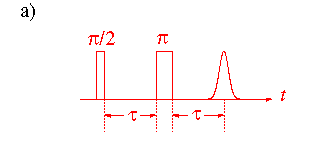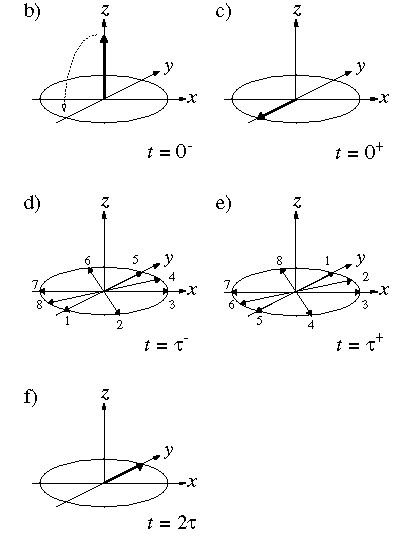Two-pulse ESEEM
In pulse EPR, the most popular sequence for the measurement of the nuclear modulation effect is still the primary echo sequence pi/2-tau-pi-tau-echo (Figure 1a). In the following the pulses are assumed to be ideally non-selective. This means in practise that the two pulses are taken as sufficiently strong and short as possible.
The creation of a primary echo can be understood in the following way. The net magnetization vector is assumed to be initially oriented along the z-axis (Figure 1b). A pi/2 pulse along x will rotate the magnetization by 90o to the -y-axis (Figure 1c). During time tau between the first and second pulse, the different spin packets freely evolve (dephasing of the different spin packets) (Figure 1d). The pi pulse inverts the y-component of the individual magnetization vectors (Figure 1e). After a time tau, the magnetization vectors are in phase along the +y-axis and a primary echo is observed (Figure 1f). From Figure 1 c-f it can be seen that the primary echo is a "pancake like" echo.
In a two-pulse ESEEM experiment, time tau between the two pulses is increased and the decay of the primary echo is monitored. The echo decays due to spin-spin and spin-lattice relaxation. Superimposed on the decaying echo amplitude, a modulation can occur if nonsecular electron-nuclear spin interactions are present. Fourier transformation of the time-domain modulation pattern yields a spectrum with frequencies directly related to the hyperfine and nuclear quadrupole interactions. The two-pulse modulation formula [1,2] shows that not only the the basic nuclear transition frequencies will be observed, but also peaks at the sum and difference frequencies. The positions of these combination frequencies can be very helpful for the interpretation of two-pulse ESEEM spectra (especially in the case of orientationally disordered systems [3])
The the decay of the echo caused by the spin-spin relaxation time T2, which is in most cases of the order of a few microseconds, is usually a serious drawback, i.e. the echo can not be followed for a sufficient long time. This problem can be overcome by using a three-pulse sequence.
References
[1] L.G. Rowan, E.L. Hahn, and W. B. Mims, "Electron spin echo envelope modulation", Phys. Rev. A, 137, 61 (1965).
[2] W. B. Mims, "Envelope modulation in spin echo experiments", Phys. Rev. B, 5, 2409 (1972).
[3] E.J. Reijerse and S.A. Dikanov, "Electron spin echo envelope modulation spectroscopy on orientationally disordered systems : Line shape singularities in S = 1/2, I=1/2 spin systems", J. Chem. Phys., 95, 836 (1991).


